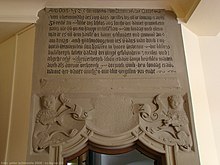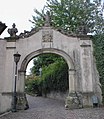Horneck Castle

The Horneck Castle was a castle of the Teutonic Order in Gundelsheim am Neckar in proximity to the Neckar Castle Ehrenberg , Guttenberg and Hornberg . Together with Guttenberg Castle, Horneck Castle dominated the so-called German Plain and the connecting routes between Heilbronn and Heidelberg . Today the palace complex serves as the home of the Transylvanian Saxons .
history
Origins
The origins of Horneck Castle are obscure. However, in 1238 a Ludovicus de Horneck was mentioned in a document. It is therefore cautiously assumed that the Lords of Horneck could be the founders and builders of the castle. The time is assumed to be around 1200. Around 1250, the owner of the castle, Konrad von Horneck, gave the castle and its part to Gundelsheim to the Teutonic Order and joined the Teutonic Order together with his two sons. In return, Konrad von Horneck became Komtur, the newly created Coming Horneck. The keep, which is still preserved today, is the only part of the building that is said to date from the time the castle was founded.
Expansion and use by the Teutonic Order
The castle was vigorously expanded and fortified by the Teutonic Order. In 1294 the order was able to acquire the remaining part of Gundelsheim (formerly imperial property ) from the Wimpfen knight's monastery in the valley . In the middle of the 14th century, the old town of Gundelsheim, located on the Neckar, was abandoned and rebuilt directly below the castle in the form of a bailey. During this time Gundelsheim was granted city rights. Around 1371, under Philipp von Bickenbach , the Kommende Horneck belonged to the chamber property of the German master. In 1401 King Ruprecht is said to have stayed twice at Horneck Castle.
With Eberhard von Seinsheim / Saunsheim , from 1420 to 1443, Horneck Castle became the preferred residence and hereditary burial of the Deutschmeister. Eberhard founded a prayer fraternity in the castle chapel in 1428 and a religious hospital in Gundelsheim in 1442. After the Teutonic Order had lost the important battle of Tannenberg against the united Poles and Lithuanians in 1410, the German masters , who were raised to the rank of imperial prince in 1494/95, at least nominally moved their permanent residence to Horneck Castle in 1438. This made Horneck Castle the third headquarters of the order, alongside Marienburg and Riga . In 1484, the Komtur der Horneck was also appointed chief bailiff of the former Mainz office of Scheuerberg . This made Horneck Castle one of the richest comers of the Teutonic Order. To strengthen the German master against the grand master, the incomes and gradients of the Coming Horneck were combined with the master class and administered by officials of the German master . In 1423 a scribe of the Deutschmeister was mentioned for the first time, around 1486 a secretary named Herbort Thiel and later a chancellor with an official residence in Gundelsheim.
With the peasant uprising in 1525 , Horneck Castle was conquered by angry peasants , probably at the behest of Götz von Berlichingen zu Hornberg , who resided on the Götzenburg Hornberg downstream . The residential and farm buildings were completely destroyed. German master Dietrich von Cleen fled to Heidelberg and then moved his headquarters, initially intended as an interim solution, to Mergentheim . After a long time, however, the final decision was made in favor of Mergentheim as the new residence. This remained so until the order was secularized in 1809. The extensive archives of the castle were also destroyed by the devastation of the peasant attack. The castle remained in the possession of the order and was immediately rebuilt. Because of their participation in the peasant uprising, the people of Gundelsheim had to pay a fine of 1000 guilders and perform labor services in the reconstruction of Horneck Castle. A massive multi-storey renaissance building was created within the mostly still preserved defensive walls and towers, which leads around the keep as an irregular heptagon and was decorated with numerous towers and oriels. The Horneck also suffered damage in the Thirty Years' War , but these were immediately repaired.
Since 1782 the Horneck became the seat of the Neckaroberamt of the Mergentheim master class , to which the offices Heilbronn , Heuchlingen , Horneck, Kirchhausen , Neckarsulm and Stocksberg counted from 1789 .
From 1720 to 1724, the builder Franz Keller converted it into a comparatively unadorned baroque palace, with the towers and bay windows from the Renaissance period being demolished. For cost reasons, the planned demolition of the keep was not carried out. In 1730, the portal to the city was finally built, which was decorated with monuments from the former castle chapel from the 15th and early 16th centuries, some of which are still preserved today as plaster casts. Above the portal are allegorical figures (bravery with a column and Christian love with a flaming urn), between which the ornate coat of arms of the high and German master Franz Ludwig von der Pfalz (1664–1732) is emblazoned by two lions.
Grave slab German master Jost von Venningen
After secularization
As a result of secularization , Horneck Castle came into the possession of the Kingdom of Württemberg in 1805 and was used as a barracks. In 1824 the facility came into private hands and served, among other things, as a hospital, sanatorium, naturopathic facility and brewery. Shortly after the Second World War, the castle was used as an American military hospital. From 1946 onwards, the castle was converted into a lung sanatorium under the direction of Rudolf Haußer . In 1960 the sanatorium moved to the newly built sanatorium in Löwenstein .
Todays use
After the sanatorium moved out in 1960, Transylvanians living in Germany acquired Saxony , which was part of the “Johannes Honterus” association. V. are united, the facility and use it to this day as the home of Transylvania . The complex contains the collections of the Transylvania Institute with an extensive library and the Transylvania Museum with an exhibition area of around 600 square meters, which sees itself as the central museum of the Transylvanian Saxons outside of Romania. Until its insolvency in 2015, the aid association "Johannes Honterus" also operated a retirement home in the castle and a nursing home in a new building next to the castle. The Federal Association of Transylvanian Saxons bought the castle for one million euros from the insolvency estate of the aid association, but without the adjoining nursing home, which was taken over by another operator. In 2016, the conversion of the former old people's home into a culture and meeting center began.
The entire complex is occasionally open to visitors, and cultural events take place in the baroque ballroom. An extensive collection of paintings with Transylvanian motifs is presented in the main building of the castle. The preserved historical building stock inside includes a portal decorated with inscriptions and a Deutschmeister grave slab from the 16th century in the library, the castle chapel, which is still used today for church services, and the ballroom on the second floor with a baroque stucco ceiling and ceiling paintings.
literature
- Jochen Goetze: Castles in the Neckar Valley . Ed. Braus, Heidelberg 1989, ISBN 3-925835-52-0
- Konrad Gündisch: History of Horneck Castle, fifth episode: in: Siebenbürgische Zeitung from March 31, 2017
Individual evidence
- ↑ Dieter J. Weiß : German Order Coming Horneck - History in: Internet presentation "Monasteries in Baden-Württemberg"
- ^ Schloss Horneck: Transylvanian Saxons dare to restart , accessed on March 3, 2018
Web links
- Horneck Castle - home of Transylvania
- Horneck Castle near AdW-Göttingen
- Illustration by Daniel Meisner from 1626: Horneck. Laetatur ob infortunia nostra ( digitized version )
- Horneck Castle on the heraldry pages of Bernhard Peter
- Horneck Castle near palaces and castles in Baden-Württemberg
Coordinates: 49 ° 17 '12.1 " N , 9 ° 9' 21.6" E

















